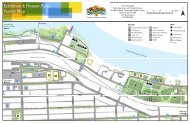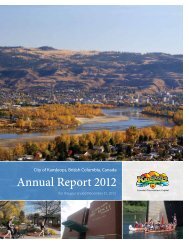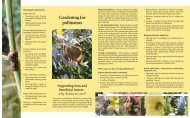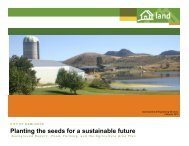GEOTOUR GUIDE - City of Kamloops
GEOTOUR GUIDE - City of Kamloops
GEOTOUR GUIDE - City of Kamloops
Create successful ePaper yourself
Turn your PDF publications into a flip-book with our unique Google optimized e-Paper software.
Figure 30a. An artistic rendering <strong>of</strong> the glacier and glacial lake that filled the Thompson rivers valleys at the end <strong>of</strong> the Ice Age.<br />
Figure 30b. The benchlands are relicts <strong>of</strong> the glacial lake floor, divided by the valley cut by the South Thompson River. (Photo by R. Turner)<br />
At the end <strong>of</strong> the Ice Age, the great ice sheet that covered the interior <strong>of</strong> British Columbia decayed. Large glacial lakes form in<br />
the present Thompson rivers valleys, their waters blocked by remaining ice. At one stage, glacier ice filled the North Thompson<br />
and Thompson valleys, and waters were temporarily dammed in the South Thompson valley, forming a glacial lake. Silt-rich<br />
glacial melt water flowed into the lake. The silt, derived from glacier grinding <strong>of</strong> rock, settled to the lake floor and over time tens<br />
<strong>of</strong> metres <strong>of</strong> sediment accumulated. Eventually, the glacier receded, releasing the lake waters, and re-establishing the South<br />
Thompson River. The river cut a valley through the s<strong>of</strong>t silt, leaving the old lake floor high and dry, as benchlands <strong>of</strong> silt. Over<br />
time, small streams cut gullies into the benchlands.<br />
“red-zone” limiTed developmenT area<br />
From the Bike Ranch viewpoint, the flat tops <strong>of</strong> the<br />
benches and the floors <strong>of</strong> the wider gullies appear to<br />
be ideal building sites for homes and buildings. The<br />
<strong>City</strong> <strong>of</strong> <strong>Kamloops</strong> built a swimming pool complex in<br />
one <strong>of</strong> the big gullies during the mid 1970s. But soon<br />
after construction, things started to go wrong. The<br />
building foundation shifted; the pool cracked and<br />
leaked. Engineers determined that the foundations<br />
had settled into small caves and tunnels within<br />
the underlying silt. Further study found numerous<br />
“sinkholes” elsewhere in the benchlands where<br />
the surface had collapsed into underground caves. Several years later, a sinkhole appeared suddenly in silt benchlands and<br />
threatened houses at Barnhartvale in easternmost <strong>Kamloops</strong>. Based on these experiences, the <strong>City</strong> <strong>of</strong> <strong>Kamloops</strong> designated<br />
the silt benchlands within the city as a special “red zone” for construction, and now strictly limits the use <strong>of</strong> these lands for<br />
development.<br />
Figure 31.<br />
Articles in <strong>Kamloops</strong> Sentinel, February<br />
1976 (Right) and Victoria Colonist, July 31,<br />
1978 (Below).<br />
20

















